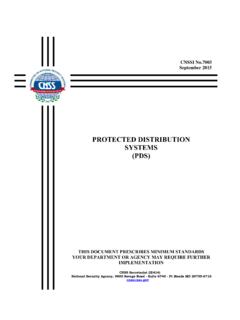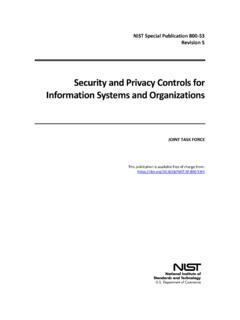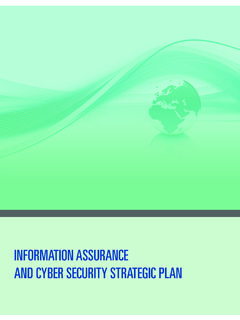Transcription of Risk Management Framework for Army Information …
1 UNCLASSIFIED Department of the Army Pamphlet 25 2 14 Information Management : Army Cybersecurity Risk Management Framework for Army Information Technology Headquarters Department of the Army Washington, DC 8 April 2019 SUMMARY DA PAM 25 2 14 Risk Management Framework for Army Information Technology This new Department of the Army pamphlet, dated 8 April 2019 o Amplifies procedures and guidance found in AR 25 2 regarding the process for obtaining and maintaining the Risk Management Framework authorizations necessary for operations of Army Information technology (throughout). o Supports the Department of Defense transition from the Department of Defense Information assurance Certification and Accreditation Process to Risk Management Framework process (throughout). o Includes roles, duties, instructions, and procedures for the Army s implementation of the Risk Management Framework (throughout).
2 DA PAM 25 2 14 8 April 2019 UNCLASSIFIED i Headquarters Department of the Army Washington, DC Department of the Army Pamphlet 25 2 14 8 April 2019 Information Management : Army Cybersecurity Risk Management Framework for Army Information Technology History. This publication is a new De-partment of the Army pamphlet. Summary. This pamphlet provides guid-ance for implementing the Risk Manage-ment Framework within the Department of the Army. It supports AR 25 2 and pro-vides amplifying procedures and guidance to DODI and DODI for Department of Defense Information tech-nology. Applicability. This pamphlet applies to the Regular Army, the Army National Guard/Army National Guard of the United States, and the Army Reserve, unless otherwise stated.
3 It also applies to all Head-quarters, Department of the Army staff; Army commands; Army service component commands; and direct reporting units. It ap-plies to all Army Information technology, operational technology, and Information in electronic format. Proponent and exception authority. The proponent for this pamphlet is the Chief Information Officer/G 6. The propo-nent has the authority to approve exceptions or waivers to this pamphlet that are con-sistent with controlling law and regulations. The proponent may delegate this approval authority, in writing, to a division chief within the proponent agency or its direct re-porting unit or field operating agency, in the grade of colonel or the civilian equivalent. Activities may request a waiver to this pam-phlet by providing justification that in-cludes a full analysis of the expected bene-fits and must include formal review by the activity s senior legal officer.
4 All waiver re-quests will be endorsed by the commander or senior leader of the requesting activity and forwarded through their higher head-quarters to the respective policy proponent. Refer to AR 25 30 for specific guidance. Suggested improvements. Users are invited to send comments and suggested improvements on DA Form 2028 (Recom-mended Changes to Publications and Blank Forms) directly to the Chief Information Officer/G 6 (SAIS PRG), 107 Army Pen-tagon, Washington, DC 20310 0107. Distribution. This pamphlet is available in electronic media only and is intended for the Regular Army, the Army National Guard/Army National Guard of the United States, and the Army Reserve. Contents (Listed by paragraph and page number) Chapter 1 Introduction, page 1 Purpose 1 1, page 1 References and forms 1 2, page 1 Explanation of abbreviations and terms 1 3, page 1 Overview 1 4, page 1 Who should use this document 1 5, page 2 Applicability and scope 1 6, page 2 Chapter 2 Army Risk Management Framework Process, page 2 Risk Management Framework overview 2 1, page 2 Army governance structure 2 2, page 2 Army cybersecurity governance 2 3, page 3 Department of Defense Information technology type definition 2 4, page 5 Department of Defense Information technology types requiring assess and authorize 2 5, page 5 Department of Defense Information technology types eligible for assess only 2 6, page 6 Chapter 3 Roles and Duties.
5 Page 6 Contents Continued ii DA PAM 25 2 14 8 April 2019 Risk Management Framework team 3 1, page 6 Army Chief Information Officer/G 6 3 2, page 7 Army senior Information security officer 3 3, page 7 Authorizing official 3 4, page 7 Authorizing official designated representative 3 5, page 7 Security control assessor 3 6, page 7 Security control assessor representative 3 7, page 8 Security control assessor validator 3 8, page 8 Security control assessor organization 3 9, page 10 Information system owner/program/system manager 3 10, page 10 Program executive officers and direct reporting program/project managers 3 11, page 11 Information system security manager 3 12, page 11 Program Information system security manager 3 13, page 11 Organization Information system security manager 3 14, page 12 Information system security officer 3 15, page 13 Chapter 4 Risk Management Framework , page 13 Six primary steps of the Risk Management Framework process 4 1, page 13 Step 1: Categorize the Information system 4 2, page 14 Security control overlays 4 3, page 15 Step 2: Select security controls 4 4, page 16 Step 3: Implement security controls 4 5, page 18 Step 4: Assess security controls and conduct remediation 4 6, page 18 Step 5: Authorize Information system 4 7, page 18 Step 6.
6 Monitor security controls 4 8, page 18 System changes 4 9, page 18 Reauthorization 4 10, page 19 Decommission 4 11, page 19 Risk Management Framework security authorization package requirements and contents 4 12, page 19 Tools that support the Army Risk Management Framework process 4 13, page 20 Reciprocity 4 14, page 21 Chapter 5 Special Considerations, page 22 Tenant enclave standards 5 1, page 22 Stand-alone Information systems/closed restricted network 5 2, page 22 Control systems 5 3, page 23 Information systems that impact financial reporting 5 4, page 24 Special access program/sensitive activity 5 5, page 25 Sensitive compartmented Information 5 6, page 25 Chapter 6 Assess Only, page 25 Implementation requirements 6 1, page 25 Terms 6 2, page 26 Platform Information technology 6 3, page 26 Assess only construct 6 4, page 27 Scenario I: Assessed not included in an existing accredited boundary 6 5, page 27 Scenario I: Requirements 6 6, page 28 Scenario II: Assessed included in an existing accredited boundary 6 7, page 28 Scenario II: Requirements 6 8, page 28 Appendixes A.
7 References, page 29 Contents Continued DA PAM 25 2 14 8 April 2019 iii Figure List Figure 2 1: Army tiered risk Management approach, page 3 Figure 2 2: Army cybersecurity governance, page 4 Figure 2 3: Department of Defense Information technology types, page 5 Figure 4 1: Risk Management Framework six-step process, page 14 Figure 4 2: Committee on National Security Systems library search for overlays, page 15 Figure 4 3: Security control families, page 17 Figure 4 4: Risk Management Framework security authorization package, page 19 Figure 5 1: Five-level control systems reference architecture, page 24 Figure 6 1: Assess only construct, page 27 Glossary DA PAM 25 2 14 8 April 2019 1 Chapter 1 Introduction 1 1. Purpose This pamphlet provides guidance for implementing AR 25 2 policy, and is designed to assist in the transition process for implementing Risk Management Framework (RMF) in Army.
8 It assists Army organizations in effectively and efficiently understanding and implementing RMF for Army Information technology (IT). The cybersecurity requirements for DOD ITs are managed through the principals established in DODI , the National Institute of Standards and Technology (NIST) Special Publication 800 37, and CNSSI 1253. AR 25 2 issues the regulation needed to ensure consistent imple-mentation of the RMF process within the life cycle of all IT. 1 2. References and forms See appendix A. 1 3. Explanation of abbreviations and terms See glossary. 1 4. Overview a. DOD adopted and implemented RMF to replace the Department of Defense Information assurance Certification and Accreditation Process (DIACAP) with the issuances of DODI and DODI b. DODI adopts the term cybersecurity and replaces the term Information assurance (IA) associated with the DIACAP throughout DOD.
9 The 2008 NSPD 54/HSPD 23 defines cybersecurity as prevention of damage to, protection of, and restoration of computers, electronic communications systems, electronic communication services, wire communi-cation, and electronic communication, including Information contained therein, to ensure its availability, integrity, authen-tication, confidentiality, and nonrepudiation. c. DODI establishes the RMF for DOD IT for cybersecurity policies, responsibilities, and risk Management within the cybersecurity life cycle for DOD IT based on DOD, NIST, and Committee on National Security Systems (CNSS) standards. d. RMF establishes a unified Information security Framework for the entire Federal Government and a risk-based ap-proach for the implementation of cybersecurity. The transition to the RMF leverages existing acquisition and systems engineering personnel, processes, and the compelling evidence (also referred to as artifacts) developed as part of systems security engineering (SSE) activities.
10 RMF employs a catalog of security controls as a baseline and requires a determina-tion of the likelihood of exploitation and the harm done if noncompliant security controls are exploited, enabling opera-tional decisions concerning authorization for initial or continuing operations. RMF emphasizes integration of cybersecurity requirements in the system s design process, resulting in a more trustworthy system that can dependably operate in the face of a capable cyber adversary. RMF also emphasizes integrating cybersecurity activities into existing processes includ-ing system security engineering (SSE), program protection planning, trusted systems and networks analysis, developmental and operational testing, financial Management and cost estimating, and sustainment through decommissioning and dis-posal.















